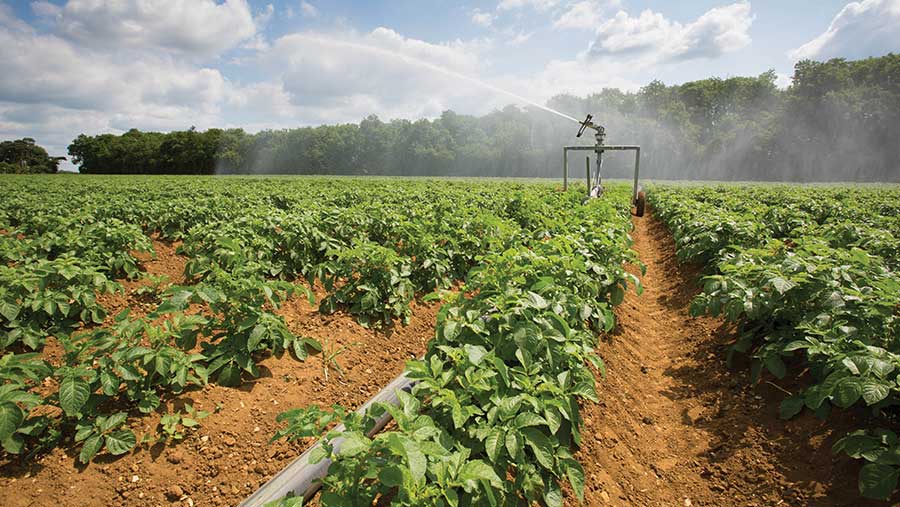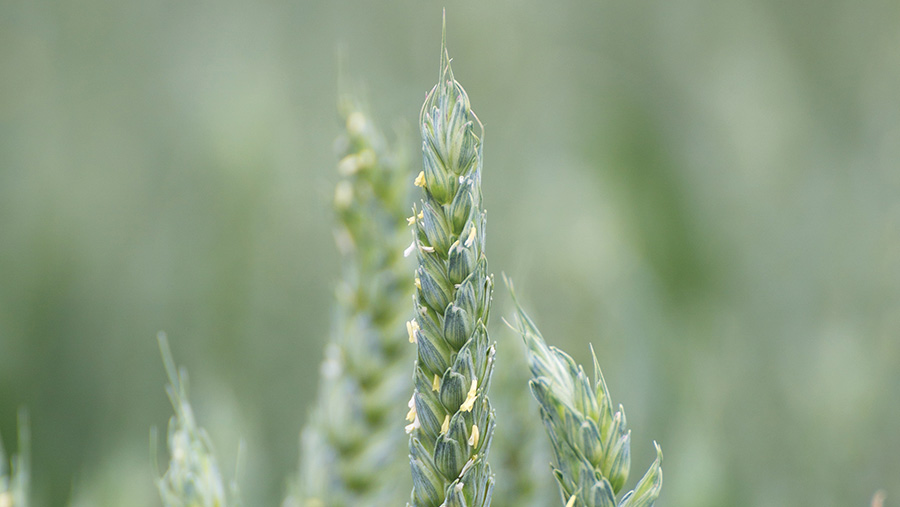Crop Watch: Rain has stopped, but woes continue
 © Tim Scrivener
© Tim Scrivener Signs of drought are being seen in crops as the higher temperatures this week stress plants.
One positive is that the lack of moisture is helping to suppress disease, leading to some growers easing off on the T3 mix with the reduced fusarium risk.
But septoria is still present and could bite back.
In Scotland, potato growers are having a tough spring with very late plantings, and they now have to irrigate at an early stage in the season.
The incessant rain may have stopped, but the challenges continue.
See also: Tips on growing profitable second wheats
North
Mary Munro, AICC/Strutt and Parker (Perthshire)
Time is marching on, and as we tackle the last rounds of spraying, it is tempting to start speculating about yield potential.
Most winter wheat crops are looking good and green.
Heads are out, or nearly out, and the earliest of my growers is doing T3 head sprays this week with a tebuconazole/prothioconazole mix.
The later ones are only a week past T2 applications.
For us in the North, dry weather means less disease, and the septoria levels are not bad at all, even in Skyscraper.
There is a bit of drought stress beginning to appear, but it has affected the spring crops more than the autumn-sown ones, in my view.
Some of our spring barleys and spring wheats looked rather miserable around growth stages 30-31, when there was clearly not much moisture around their roots, and uptake of nutrients and trace elements was somewhat restricted.
There has been enough dampness in the dew to wash in the fertiliser, and the roots have pushed down to find water.
These crops have all rallied in the past week or so.
Yellow rust
I am finding much less yellow rust in spring wheat this year, which is a great relief.
However, interestingly, it seems to be striking the spring barley crops further north in Aberdeenshire, which is most unusual.
Rhynchosporium has not featured much so far this season and the barley T2s will give a top-up of protection.
Ramularia is always a threat at this later stage, but the dry weather may help to reduce disease pressure.
It is beginning to appear in some winter barleys now, which will speed up the senescence process in an unwelcome way, as these crops will not be sprayed again.
I have a larger area of spring beans to walk this year and these are beginning to flower.
A mid-flowering application of tebuconazole is planned and, if disease pressure increases, they may get a later application of half-rate Signum (boscalid + pyraclostrobin).
There is a lot of irrigation going onto potatoes now. It has been a difficult spring for potato growers – a very late planting season and now irrigation at an early stage, which has to be sustained once started.
East
Marion Self, AICC/Prime Agriculture (Suffolk)
Wheat ears have emerged and, as the spray season draws to a close, we hope for sunshine and a measured amount of rain to fill the grain.
In Suffolk, we have been without rain for more than a month and crops on lighter land are drought stressed.
Wheats look well on heavier land, although a closer look into the canopy reveals a heavy population of septoria, which is, thankfully, being held at bay by the drier conditions.
T3 ear sprays to top up foliar disease control and protect the ear from disease are nearly complete; dry weather during flowering will have reduced fusarium infection.
Septoria remains the main cause of leaf scorch, and varieties with a Recommended List rating above 7 are significantly cleaner.
This season has clearly demonstrated that earlier-drilled, thick, forward crops are more disease susceptible; septoria being particularly tricky.
And we have also been very visually reminded of the influence of drilling date on other factors such as grassweed population and barley yellow dwarf virus infection.
Where a foliar nitrogen is planned on milling wheats to increase grain N, this can be applied from watery to milky ripe.
Take care to avoid scorch by applying this in cooler, dull conditions, and add water if necessary.
In the main, spring barley looks well alongside earlier-drilled beet and pulses.
Later-drilled spring crops have been slow to establish in the cool, dry conditions we’ve had in the East, but they are now finding their feet.
Pea pests
Monitor peas for aphids, pea moth and pea midge. Remember pirimicarb (such as Aphox) can only be applied once (maximum dose 280g/ha of active ingredient) from first flower buds visible.
Warm weather has also encouraged more aphids into the beet crop; the British Beet Research Organisation threshold for applying insecticide is one wingless aphid per four plants up to when the 12-leaf stage is reached. It’s one per plant after that.
Any slow-growing Cruiser-treated crops not already at 12 leaves should also be monitored as the seed treatment reaches the end of its persistence.
Herbicide applications are largely completed as beet growth closes the row, and crops are receiving a tonic of nutrients to promote canopy growth and health.
As this agronomy season comes to a close, make time to plan for next year.
We can never mitigate against all the challenges it will bring, but there is always something to learn and a chance to start afresh.
Consider your fundamental agronomic strategy; are there changes you should make?
Adjustments to cropping choice, rotation, cultivations, variety choice and drilling date could all help reduce risk, increase sustainability and lower the cost of production.
West
Antony Wade, Hillhampton Technical Services (Hereford/Shropshire)
As I look back on my previous Crop Watch piece, I find it unbelievable how the British weather can swing from a wet weather pattern to a dry one, driven by the jet stream.
Last time I was lamenting wading through deep tramlines full of water; now the challenge is the same deep tramlines, but they are dry and hard, with cracks that test the ankle ligaments, following at least three weeks without significant rain.
The cool north-easterly wind that has accompanied this dry period has increased the drying effect, while keeping temperatures in check, which has been fortunate for crops, although temperatures are forecast to rise to the high 20s.
Spring crops that went in late, generally due to the previous excess soil moisture problems, are now starting to suffer from the lack of moisture, so they are desperately in need of some rain to help them.
Some spring barley and spring bean crops that are hardly above shin height at the moment will not have much more biomass by harvest time, which will have an effect on yield.
Maize that went in later than normal is starting to grow away with the warmer weather. Pre-emergence herbicides have done a reasonable job and the dry weather has resulted in a slower flush of later-germinating weeds.
However, the post-emergence herbicides have been deployed and we just have to hope we don’t get a late flush of weeds if there is any rain.
Brome and ryegrass
Winter barley crops that made for pleasant viewing in May as they came into ear are now starting to turn, but some crops are not so good to look at as brome and ryegrass start to pop up above the crop.
They do look to have good yield potential, which will be a blessing. The radiation has just come in time, so let’s hope they don’t flatter to deceive, as they often do.
The sun and dry weather also, hopefully, came just in time, hopefully, towards the end of flowering in oilseed rape crops.
I resisted the temptation to apply a late-flowering sclerotinia fungicide with the onset of the warmer, drier weather.
Time will tell, but the early signs are that this was the correct decision.
With the current value of the crops, any growing cost savings are needed. They look to have good yield potential, which may help to offset this.
Septoria pressure in wheat has been unprecedented, so we are now coming to crunch time to find out how successful we have been with our fungicide programmes.
Robust flag-leaf sprays and drier weather means we have held the epidemic, but we have significant infections on leaves two and three.
The effect this will have on yield will be the final judge whether our increased spend on the fungicide strategy, due to increased dosage and the cost of the best fungicides, was justified.
It will be interesting to see how long we can hold on to green leaf area through grain filling, especially where we have used the best new chemistry together.
The dry weather has made the T3 decision easier, as most have flowered in dry, low-risk fusarium conditions. Yellow rust has generally not been an issue and has been controlled well by the fungicide programme.
But it’s worrying that some of the newer varieties with a robust rating are showing some foci around the T2 timing. Samples have been sent to investigate these concerns.
Some second wheats on lighter land are showing evidence of leaf rolling with the lack of recent rain.
Grassweed control has again been difficult, so some reviewing of strategies will be needed. With current crop values and increased costs, it is not sustainable to keep throwing the kitchen sink at these problems.
South
Jamie Swift, Procam (East Sussex)
With summer now upon us, it’s easy to forget what a challenging spring it has been, with winter crops entering June largely in good order.
It has been hard work to meet fungicide timings throughout the spring due to months of unsettled weather. However, sufficient moisture throughout has been a welcome aid to our effort, which has delivered healthy plants that are well equipped for the current warm weather.
T3s represent the final roll of the dice, as penultimate fungicide applications are now being applied with wheats fully in ear.

© Tim Scrivener
T3s must be applied when wheat crops are at mid-flowering – no earlier, no later. Poor timing can result in up to 30% yield loss as well as reduced specific weights.
As ever, the weather will have a big say when it comes to applying in good time. That said, I won’t be taking any risks at T3, ensuring a robust mix where necessary.
With fusarium the main target now, products containing prothioconazole and tebuconazole should demonstrate the greatest efficacy with the inclusion of an SDHI or a strobilurin where any late septoria or mildew is an issue.
Spring crops
Spring crops are a mixed bag. Having been drilled into good moisture, crops are now showing signs of stress as day-time temperatures reach 30C.
Spring barleys are all over the place, with some crops having had a T2 fungicide and others just approaching the T0 stage.
“We could do with a shower” is a common start to conversations with growers at the moment.
Elsewhere, peas and beans will require a fungicide application this month before we shut the gate, and oilseed rape campaigns have all but come to an end, bar pod sealant applications and pre-harvest desiccation.
We are seeing high winds in the South, so to ensure pods are retained I’ll be turning to Mesh from De Sangosse for greater protection should we see any further adverse weather.

